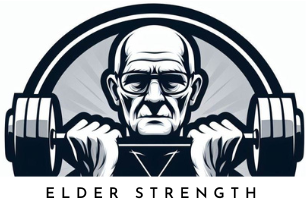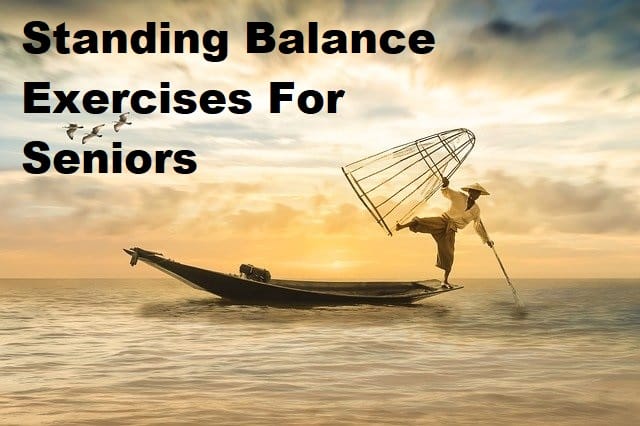Welcome friend! In this article, you will learn about standing balance exercises for seniors and why balance training is so important as you age.
Besides strength training, balance training is probably the most important form of exercise for your long-term health.
The benefits of balance training are not as obvious though, since you don’t really think about your balance day-to-day.
You might notice occasionally that you feel a bit clumsier compared to a younger self but most of the time the ability to maintain balance is taken for granted.
And that’s why losing it is so treacherous. You don’t realize it’s gone until it’s too late. You might slip or stumble and end up falling. Sometimes with dire consequences.
Falling accidents are extremely common among seniors and unfortunately often cause serious injuries like hip or wrist fractures.
While aging will unavoidably affect your balance there’s a lot you can do to prevent age-related decline in balance skills and ability.
In this article, you will learn a few simple exercises that will go a long way to help you maintain your balance skills. Just don’t forget about strength training as your balance is highly dependent on your leg strength and mobility.
Balance And Aging
Before we look at the exercises let’s talk a bit about why balance training is so important as you age.
Your ability to stay upright while walking and moving around is something you probably take for granted. In all likelihood, you learned how to do it as a small child and since then you probably haven’t paid much attention to it.
The truth is that balance is an extremely complex skill that challenges your central nervous system constantly.
Your eyes, vestibular system, and proprioception constantly feed information about your orientation and position in space to your nervous system.
Your muscles make countless microscopic adjustments every second you are standing upright. Since you’ve learned the skill, this all happens automatically.
Aging affects every single part of the system that makes up your balance. Aging affects your sensors, i.e. eyes, vestibular system, and proprioception.
Aging also affects your central nervous system’s ability to process the information coming from your sensors. Medication and conditions that affect the central nervous system can degrade your balance significantly.
Most importantly aging affects your muscle strength and reaction time as well as mobility. This directly hinders your body’s ability to make adjustive movements.
As we age, we also tend to move less and with less variety, which also degrades our muscle memory for balance. You know what they say about riding a bike, but if you don’t ride a bike for 40 years, you might be in for a surprise.
Because of this age-related decline in balance, it’s very important to keep fit and challenge your balance through varied exercise.
Learn more about the balance skill and how aging affects it.
A Word About Safety
A quick word about safety before we look at the exercises. The aim of these exercises is to prevent falling by challenging your balance.
That means that there is a very real risk of losing your balance and falling while performing them. If performed slowly and close to a sturdy support, the risk is small but it’s still very real.
A simple fall at your home can lead to the same injuries as falling anywhere else so it’s very important to take safety seriously.
Make sure your feet are not slippery, have something sturdy for support, make sure there are no dangerous objects to fall onto. It’s also very wise to have someone with you while performing balance training.
I also have to mention that you are performing these exercises at your own risk and I can’t be held responsible for any injury or loss, you can read the full disclaimer here. So use common sense and know your limits. If you have any hesitations, consult someone who can advise and assist you in person.
Now that we got the important stuff out of the way, let’s look at the best standing balance exercises for seniors!
Exercise 1: One Leg Stand
This is a simple one and very intuitive. Standing on one leg is a great way to test, improve and challenge your balance.
To perform this exercise you simply stand still and lift one knee up in front of you. You can try different positions for the raised leg or you can even support it to your other leg.
I recommend you start with a very low position, i.e. only slightly raise the other leg. This reduces the time to regain balance if you start to fall.
You should also have something for support to hold on to, a sturdy chair or a table will usually do the trick.
See how long you can keep balance with one leg and then change to the next. Then try to improve your time a couple of times per leg. This can be done several times a week or even every day.
Don’t worry if it feels very hard at first. Just keep trying while using a table or something similar for support.
Another tip is to keep your eyes fixed on a single spot in front of you at eye level. A much harder version of this test is to do it eyes closed, but this should never be attempted along because the fall risk is very high.
Here’s a great example of the exercise on YouTube by Caregiver Stress (YouTube embed, ElderStrength does not own the content).
Exercise 2: Alternate Single Leg Lift
This is a variation of the one-leg stand that’s also great for strengthening the hip flexors.
The exercise is performed by raising the knee of one leg as high as you can toward your chest and lowering it down and repeating the exercise with the other leg.
You can try different tempos and even hold your legs up for a second or two to add difficulty.
This exercise is great because it includes dynamic movement while challenging your balance. Since balance is a complex skill, it’s not enough to just maintain it while standing after all.
Here’s a great example of the exercise on YouTube by DiTuroProductions
Exercise 3: Leg Side Lift
This exercise is yet another variation of the one-leg stand and the single-leg lift. In this variation, you will stand still and swing your leg to the side instead of moving it in front of you.
This will challenge your balance in a different plane than the single-leg lift so it’s great for variety. The side lift is also a great exercise for improving hip abductor strength.
Here’s a great example of the exercise on YouTube by Caregiver Stress
Exercise 4: Balance Board Training
Finally, a great way to improve your balance while standing up is to use a balance board.
Balance boards are very effective and simple tools for improving balance. They can also be fun and relatively safe if you keep the safety precautions in mind.
Balance boards are simple boards with a fulcrum either for one or two planes. The idea is to balance yourself on the board over the fulcrum. Kind of like a seesaw with your legs.
From the link below you can find my recommendations for the best balance boards for seniors with some tips for exercises.
Here you can find my recommendations for the best balance boards for seniors.
Conclusion
I hope you found this post about standing balance exercises for seniors useful. If you have any questions, feel free to leave them in the comments section below and I will get back to you!
As a recap, balance training is very important as you age because aging affects every single part of the system that makes up your ability to keep balance.
Standing balance exercises are very effective, simple, and free so they are a great way to maintain your balance skills. Just make sure you are doing them in safe surroundings and know your limits.
Besides balance exercises, it’s important to do strength training to maintain and improve leg strength as the balance is also dependant on your leg strength in extreme situations like slipping or stumbling.
Because balance is a very complex skill, the more diverse movement and exercise you include in your day, the better. Cycling, yoga, Tai-Chi, kayaking, golf, walking, jogging, and even swimming are all great forms of exercise for challenging and improving your balance skills.
Thanks for reading and see you next time!

